
|
|
||||
|
|
|
|
||
| Open A | ||||
| Participants | ||||
| Starting rank list | ||||
| Results/Pairings | ||||
| 1 2 3 4 5 6 7 8 9 | ||||
| Table | ||||
| 7 8 9 | ||||
| ONLINE | ||||
| Server 1 Server 2 | ||||
| Games | ||||
| PGN | ||||
| Download | ||||
| Photo | ||||
| 1 2 3 4 5 6 7 8 9 10 11 | ||||
| Commentary | ||||
| 1 2 3 4 5 6 7 8 | ||||
| Interview | ||||
| 1 2 | ||||
| Open B | ||||
| Participants | ||||
| Starting rank list | ||||
| Results/Pairings | ||||
| 1 2 3 4 5 6 7 8 9 | ||||
| Table | ||||
| 7 8 9 | ||||
| PGN | ||||
| Download | ||||
| Photo | ||||
| 1 2 3 4 5 6 7 | ||||
| Open C | ||||
| Participants | ||||
| Starting rank list | ||||
| Results/Pairings | ||||
| 1 2 3 4 5 6 7 8 9 | ||||
| Table | ||||
| 7 8 9 | ||||
| ONLINE | ||||
| Server 1 Server 2 | ||||
| Games | ||||
| PGN | ||||
| Download | ||||
| Photo | ||||
| 1 2 3 4 5 6 7 8 9 10 11 12 | ||||
| Interview | ||||
| 1 2 | ||||
| Open D | ||||
| Participants | ||||
| Starting rank list | ||||
| Results/Pairings | ||||
| 1 2 3 4 5 6 7 8 9 | ||||
| Table | ||||
| 7 8 9 | ||||
| PGN | ||||
| Download | ||||
| Photo | ||||
| 1 2 3 4 5 6 7 8 | ||||
| Interview | ||||
| 1 2 | ||||
| Open E1 | ||||
| Participants | ||||
| Starting rank list | ||||
| Results/Pairings | ||||
| 1 2 3 4 5 6 7 8 | ||||
| Table | ||||
| 7 8 | ||||
| Photo | ||||
| 1 2 3 4 5 6 7 8 9 10 11 12 13 | ||||
| PGN | ||||
| Download | ||||
| Open E2, E3 | ||||
| Table | ||||
| Table | ||||
| Open F | ||||
| Participants | ||||
| Starting rank list | ||||
| Photo | ||||
| 1 | ||||
| Table | ||||
| Table | ||||
| International research Conference | ||||
| News | ||||
| 1 2 | ||||
| Program | ||||
| Resolution | ||||
| Summary | ||||
| Photo | ||||
| 1 2 | ||||
| Arbiter's seminar | ||||
| Photo | ||||
| 1 | ||||
| Photo | ||||
| Opening ceremony | ||||
| Segui | ||||
| M.E.Nikolaev visit | ||||
| Closing ceremony | ||||
| Press releases | ||||
| Press releases | ||||
| 1 2 3 4 5 6 7 8 9 10 11 12 13 14 15 16 17 | ||||
| MOSCOW OPEN 2005-2009 | ||||
| 2005 | ||||
| Festival 2005 | ||||
| 2006 | ||||
| Festival 2006 | ||||
| 2007 | ||||
| Festival 2007 | ||||
| 2008 | ||||
| Festival 2008 | ||||
| 2009 | ||||
| Festival 2009 | ||||
| Links | ||||
| Moscow chess federation | ||||
| Official site | ||||
| Moscow Sport committee | ||||
| Official site | ||||
| Russian Chess Federation | ||||
| Official site | ||||
| FIDE | ||||
| Official site | ||||
|
|
||||
 |
|
|
Game is commented by IM Vladimir Barsky
A.Evdokimov – D.Gochelashvili
King's Indian Defence
1.d4 Nf6 2.c4 g6 3.Nc3 Bg7 4.e4 d6 5.Nf3 0-0 6.Be2 e5 7.0-0 Na6
In classical system of King's Indian Defence Black prefer Nñ6 and after 8.d5 Ne7 send it on the king side to support the attack. Move in the game is less arrogant: Black thinks to strengthening the point ñ5.
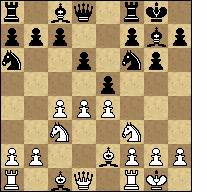
8.Be3 Ng4 9.Bg5 Qe8 10.dxe5 dxe5 11.h3 h6 12.Bd2 Nf6 13.Be3 Qe7 14.Nd5 Qd8 15.Qc1 Kh7 16.Rd1 Nxe4
Opponents reproduced a long theoretical variant till now, but White has spent much more time for that.
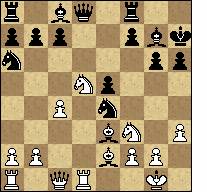
17.Nb6
Probably, more perspective 17.c5, and only in case of 17 … c6 to take a Queen - 18.Nb6. In the game Sandipan - Arakhamia-Grant (Philadelphia 2007) White have achieved the notable overweight after18…Qe7 19.Nxa8 Be6 20.Bxa6 bxa6 21.Nb6 axb6 22.cxb6 Bd5 23.Nd2 Nxd2 24.Rxd2 etc
17...axb6 18.Rxd8 Rxd8 19.Qe1 Be6
Novelty. Earlier way played 19... Nec5 20.Rd1 Be6 21.a3 Rxd1 22.Qxd1 Nd7 23.b4 Nab8 24.Qc1 Nc6 25.Bd3 Nd4 26.Bxd4 exd4 27.h4 Kg8 28.Nd2 Ne5 etc., Cordova - Valdes, Habana 2008.
Black has a sufficient equivalent for a Queen - Rook, Knight and a Pawn. As it is known, the Queen is especially strong in an open position, but White is difficult to open the lines.
20.Rd1 Nd6
Black avoid exchanges. White have the easier game after 20... Rxd1 21.Qxd1 Nb4 (obviously bad 21... Nb8? 22.Qd8) 22.Nd2! Nxd2 23.Qxd2, and it is bad 23 … Nxa2? (correct 23... Nc6 24.b3 with mutual chances) 24.Bf3, and Black is difficult to return a Knight in a struggle.
21.b3 Nb8 22.a4 Nc6 23.h4
Was worthy 23.Nd2 Nf5 24.Bf3, trying to make active the minor pieces.
23...Nf5 24.h5 g5

25.Rxd8
White could try a curious sacrifice here - 25.Bxg5!? hxg5 26.Nxg5 + Kh8 27.Nxe6 fxe6 28.Bf3, and Rybka estimates a position as an equal.
25...Rxd8 26.Qb1 Kg8 27.Bd3 Nxe3 28.fxe3 Ne7 29.Nh2?!
The sluggish maneuver allowing Black to grasp the space in the centre. It was better 29.Qc2, aspiring to spend c4-c5.
29...f5 30.Nf1?!
It’s consistently, but unsuccessful. White should have played: 30.e4 f4 31.c5 bxc5 32.Bc4, with a good counterplay.
30...e4 31.Bc2 g4 32.Qe1 Nc6?!
It seems logical – Knight goes to the enemy camp through å5, however it was correct 32... Be5 33.Ng3 c5 34.Ne2 Bf7 35.Nf4 Nc6 with obvious overweight of Black
33.Ng3 Ne5
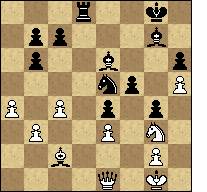
34.Ne2?
White miss the chance which consisted in a piece sacrifice after 34.Qf1! Rd2 (34...Rf8 35.Ne2 not dangerous for Black) 35.Nxf5 Bxf5 36.Qxf5 Rxc2 37.Qe6+ Kh8 38.Qc8+ Kh7 39.Qf5+ Kg8 40.Qe6+, and Black should agree with a drawn as after 40…Kf8 41.Qc8+ White has even chances to win.
34...Nd3 35.Qh4
35.Bxd3 exd3 36.Qd2 Rd6 37.Nf4 Bc3! 38.Qd1 d2 etc
35...Rd7 36.Nd4 Kf7!
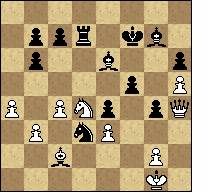
37.Kf1
37.Nxe6 Kxe6 38.Qg3 Be5 39.Qh4 g3 - Can not help for White.
37...Bf6 38.Qh2 Be5 39.Qh4 Bxd4 40.exd4 Rxd4 41.Bxd3 exd3 42.Qf2 c5 43.Qd2 f4
Even better 43...g3! 44.Kg1 f4 45.Kf1 Bg4 etc.
44.g3 Bf5 45.gxf4 Re4
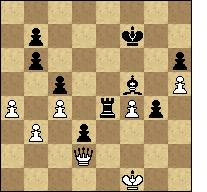
46.Qc3
46.Qxd3? Rxf4+.
46...Re2 47.Qh8 g3 48.Qd8 Bh3+
White resigns.|
|
|
|||||||||||||||||||||||||||||
|
|
|
|
|
|
|
|||||||||||||||||||||||||
|
|
|
|
|
|||||||||||||||||||||||||||
|
|
|
|
|
|||||||||||||||||||||||||||
|
|
|
|
|
|||||||||||||||||||||||||||
|
|
|
|
||||||||||||||||||||||||||||
|
|
|
|||||||||||||||||||||||||||||
|
|
|
|||||||||||||||||||||||||||||
|
|
|
|||||||||||||||||||||||||||||
|
|
|
|
|
|||||||||||||||||||||||||||
|
|
|
|
|
|
|
|
|
|
|
|||||||||||||||||||||
|
|
|
|
|
|||||||||||||||||||||||||||
|
|
|
|
|
|
|
|
||||||||||||||||||||||||
|
|
|
|
|
|
|
|||||||||||||||||||||||||
|
|
|
|
||||||||||||||||||||||||||||
|
|
|
|
||||||||||||||||||||||||||||
|
|
|
|
|
|||||||||||||||||||||||||||
|
|
|
|
||||||||||||||||||||||||||||
|
|
|
|||||||||||||||||||||||||||||
|
|
|
|
|
|
|
|
|
|
|
|
|
|
|
|
|
|
|
|
|
|
|
|
|
|
|
|
|
|
|
|